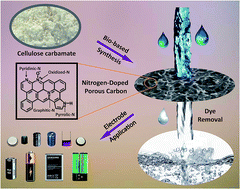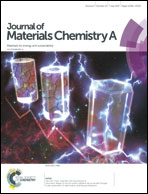Biomass based nitrogen-doped structure-tunable versatile porous carbon materials†
Abstract
Hierarchical nitrogen-doped porous carbons (HNPCs) with tunable pore structures and ultrahigh specific surface areas were designed and prepared from sustainable biomass precursor cellulose carbamate via simultaneous carbonization and activation by a facile one-pot approach. The as-synthesized HNPCs exhibited an ultrahigh specific surface area (3700 m2 g−1), a high pore volume (3.60 cm3 g−1) and a high level of nitrogen-doping (7.7%). The HNPCs were structurally tunable in terms of their pore structure and morphology by adjusting the calcination temperature. In three-electrode systems, the electrode made of HNPCs prepared at 900 °C (HNPCs-900) showed a high specific capacitance of 339 F g−1 in 6 M KOH aqueous electrolyte and 282 F g−1 in 1 M H2SO4 electrolyte at a current density of 0.5 A g−1. An outstanding rate capability (∼73% retention at a current density of 20 A g−1) and excellent cycling stability (∼95% retention after 5000 galvanostatic charge–discharge cycles at a current density of 5 A g−1) in KOH electrolyte were achieved. In two-electrode systems, the electrode made of HNPCs-900 exhibited a high specific capacitance of 289 F g−1 at 0.5 A g−1 and good rate capacity (∼72% retention at a current density of 20 A g−1) as well as cycling stability (∼92% retention at 2 A g−1) after 5000 cycles. Furthermore, the HNPCs-900 showed an unprecedented adsorption capacity for methylene blue (1551 mg g−1) which was among the few highest ever reported for dye removal. The HNPCs could be used as functional materials for energy storage and waste water treatment.



 Please wait while we load your content...
Please wait while we load your content...